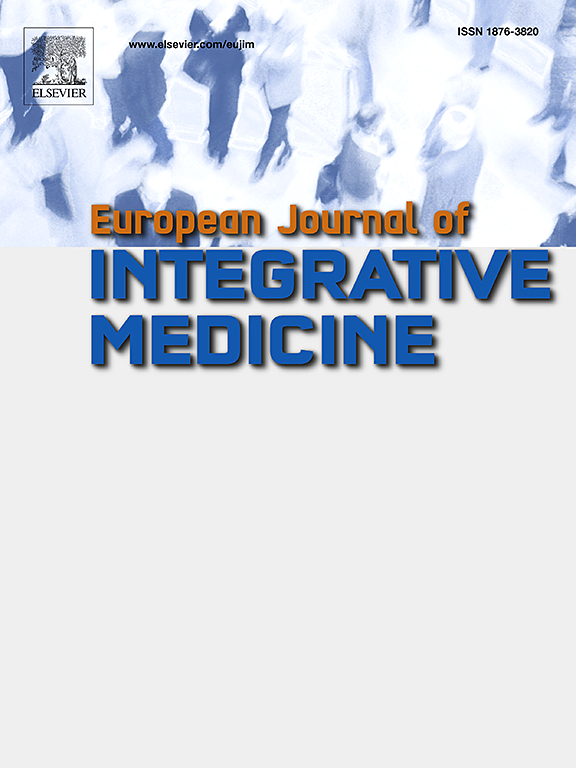Global trends and hotspots in acupuncture for hypertension: a bibliometric study from 1994 to 2024
IF 1.7
4区 医学
Q3 INTEGRATIVE & COMPLEMENTARY MEDICINE
引用次数: 0
Abstract
Introduction
Growing interest in non-pharmacological hypertension management has led to increased research in acupuncture as a potential treatment. This bibliometric analysis examines the global research landscape of acupuncture for hypertension using CiteSpace and VOS Viewer software. By analyzing publication trends, key contributors, and collaborative networks, we summarize the current state of research, identify emerging hotspots, and outline future directions in this rapidly evolving field.
Methods
We conducted a comprehensive literature search in the Web of Science Core Collection (WOSCC), including the Science Citation Index Expanded (SCI-E) and Emerging Sources Citation Index (ESCI) databases, covering publications from 1994 to 2024. Bibliometric analysis and knowledge mapping were performed using CiteSpace (version 6.2.R4) and VOS Viewer (version 1.6.18) to analyze publication trends, research collaborations, and thematic evolution.
Results
The analysis revealed a consistent upward trend in annual publications from 1994 to 2024, with China emerging as the most productive country in this research domain. Key thematic clusters identified through keyword analysis included "acupuncture," "stimulation," "blood pressure regulation," and "electroacupuncture." Co-citation analysis demonstrated significant research intensity for "systemic hypertension" (cluster strength: 6.94, 2015–2019), "randomized controlled trials" (4.31, 2022–2024), and "neurons" (3.9, 2012–2013). The study by Frank A Flachskampf et al. (burst strength = 8.48) showed the strongest citation burst.
Conclusion
Our bibliometric analysis reveals a marked surge in research output and scientific engagement, underscoring acupuncture’s expanding role as a therapeutic intervention for hypertension. The field exhibits robust growth potential, driven by intensifying global collaboration among leading institutions and interdisciplinary research teams.
针灸治疗高血压的全球趋势和热点:1994 - 2024年文献计量学研究
随着人们对非药物高血压治疗的兴趣日益浓厚,针灸作为一种潜在的治疗方法的研究也越来越多。本文使用CiteSpace和VOS Viewer软件对针灸治疗高血压的全球研究现状进行了文献计量分析。通过分析出版趋势、主要贡献者和合作网络,我们总结了研究现状,确定了新兴热点,并概述了这个快速发展领域的未来方向。方法对Web of Science Core Collection (WOSCC)进行全面的文献检索,包括Science Citation Index Expanded (SCI-E)和Emerging Sources Citation Index (ESCI)数据库,检索时间为1994 - 2024年。使用CiteSpace (version 6.2.R4)和VOS Viewer (version 1.6.18)进行文献计量分析和知识图谱分析,分析出版趋势、研究合作和专题演变。结果分析显示,从1994年到2024年,中国的年度出版物数量呈持续上升趋势,中国成为该研究领域产量最高的国家。通过关键词分析确定的关键主题集群包括“针灸”、“刺激”、“血压调节”和“电针”。共引分析显示,“全体性高血压”(聚类强度:6.94,2015-2019)、“随机对照试验”(聚类强度:4.31,2022-2024)和“神经元”(聚类强度:3.9,2012-2013)的研究强度显著。Frank A Flachskampf等人的研究(burst strength = 8.48)表现出最强的引文爆发。我们的文献计量分析显示,研究产出和科学参与显著增加,强调了针灸作为高血压治疗干预措施的作用日益扩大。在全球领先机构和跨学科研究团队加强合作的推动下,该领域显示出强劲的增长潜力。
本文章由计算机程序翻译,如有差异,请以英文原文为准。
求助全文
约1分钟内获得全文
求助全文
来源期刊

European Journal of Integrative Medicine
INTEGRATIVE & COMPLEMENTARY MEDICINE-
CiteScore
4.70
自引率
4.00%
发文量
102
审稿时长
33 days
期刊介绍:
The European Journal of Integrative Medicine (EuJIM) considers manuscripts from a wide range of complementary and integrative health care disciplines, with a particular focus on whole systems approaches, public health, self management and traditional medical systems. The journal strives to connect conventional medicine and evidence based complementary medicine. We encourage submissions reporting research with relevance for integrative clinical practice and interprofessional education.
EuJIM aims to be of interest to both conventional and integrative audiences, including healthcare practitioners, researchers, health care organisations, educationalists, and all those who seek objective and critical information on integrative medicine. To achieve this aim EuJIM provides an innovative international and interdisciplinary platform linking researchers and clinicians.
The journal focuses primarily on original research articles including systematic reviews, randomized controlled trials, other clinical studies, qualitative, observational and epidemiological studies. In addition we welcome short reviews, opinion articles and contributions relating to health services and policy, health economics and psychology.
 求助内容:
求助内容: 应助结果提醒方式:
应助结果提醒方式:


